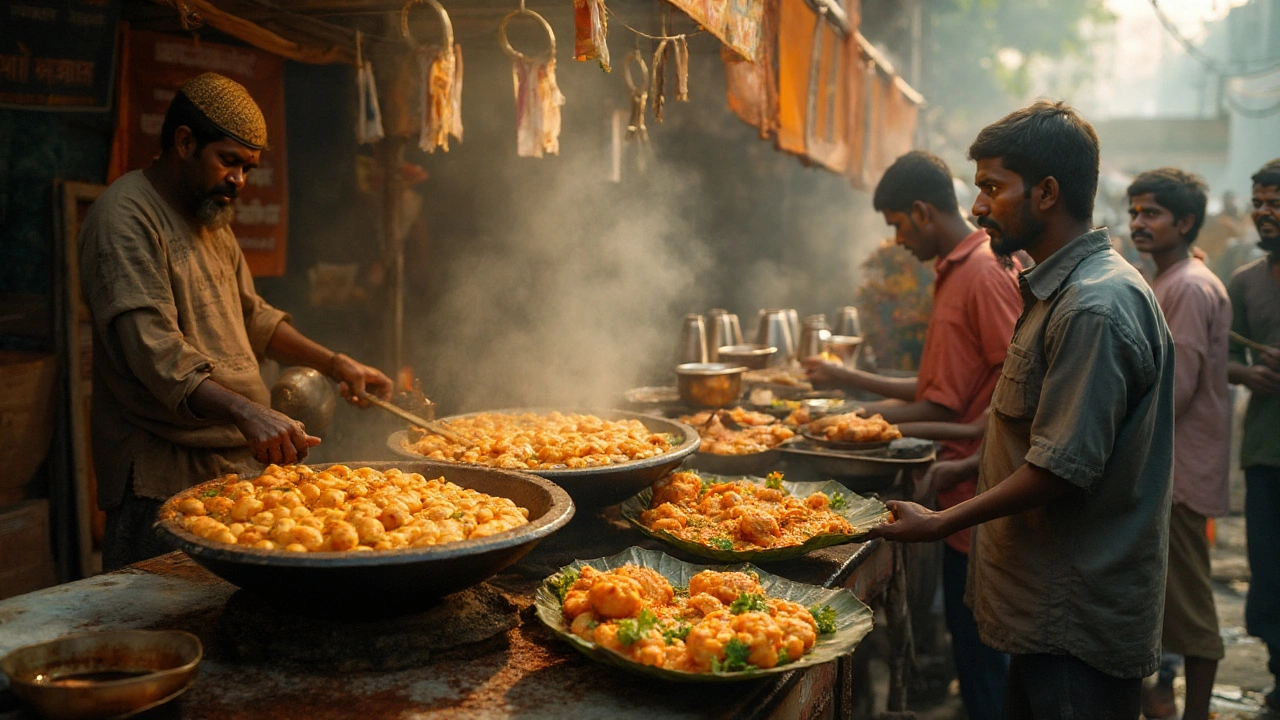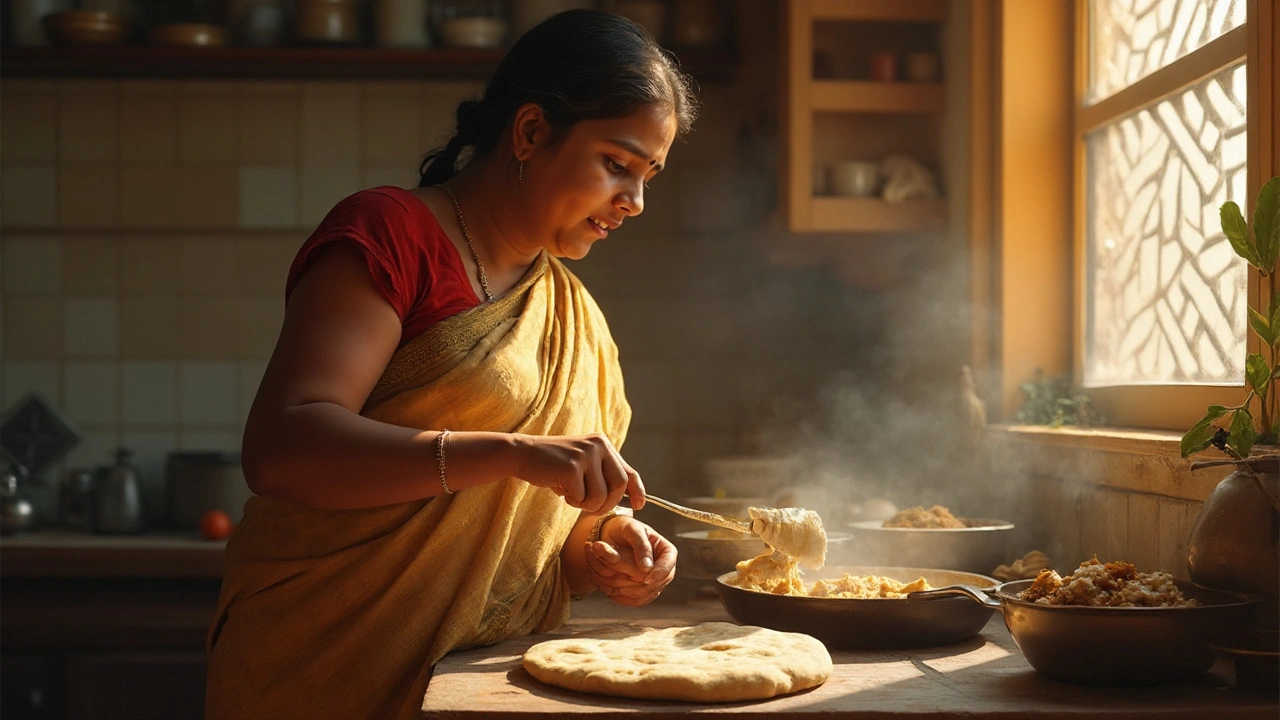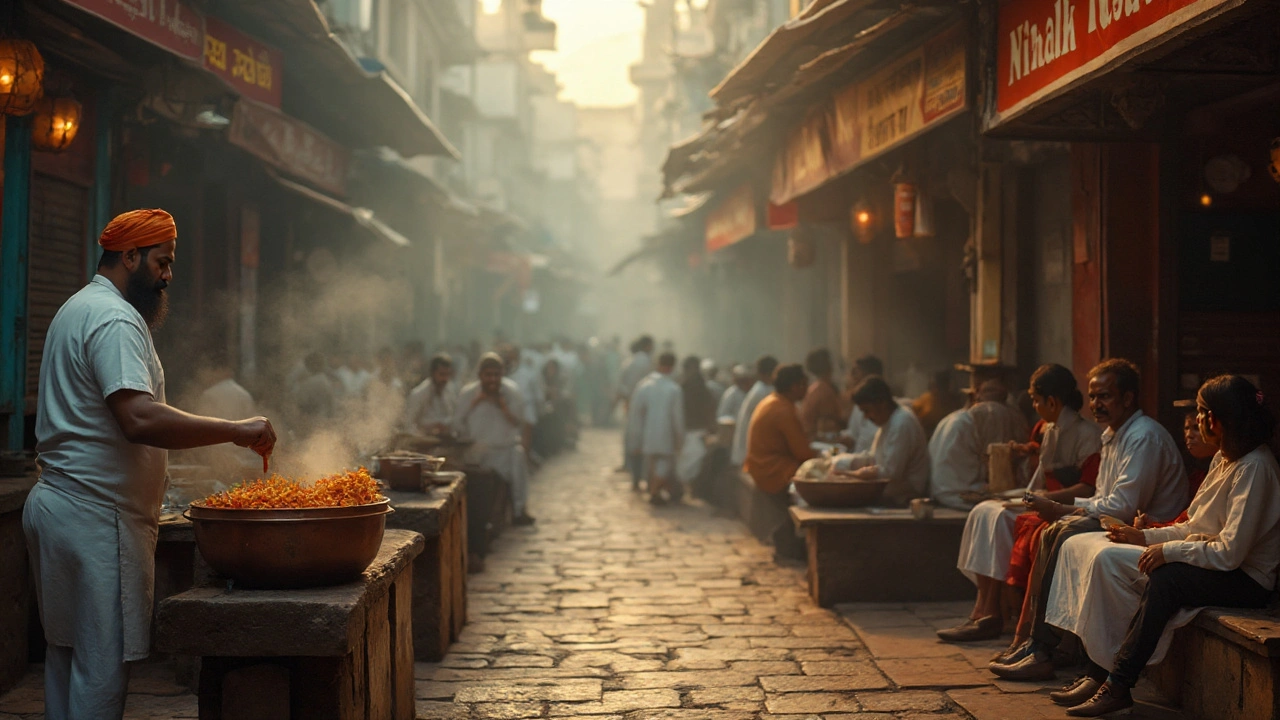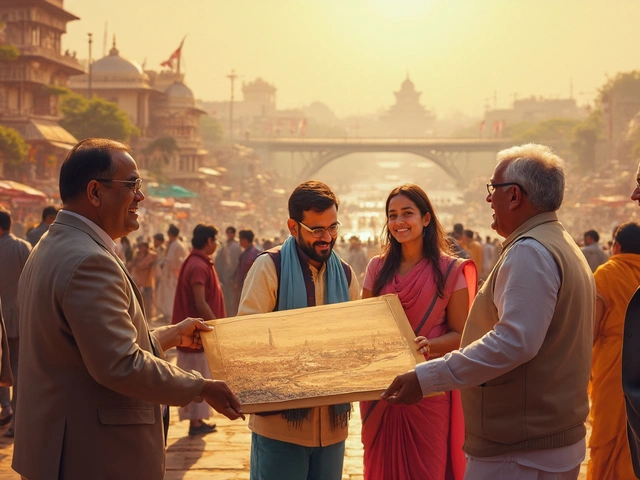Uttar Pradesh Breakfast: What People Actually Eat (Poori-Sabzi, Kachori, Jalebi, Lucknow Picks)
You clicked to find the breakfast food of Uttar Pradesh. Here’s the honest answer: there isn’t one. UP is huge-bigger than many countries-so morning plates swing from fiery kachori-sabzi in Varanasi to rich nihari with sheermal in old Lucknow, to aloo parathas and lassi in the west. Expect carbs, heat, and a lot of chai.
- Quick answer: Poori- or kachori-sabzi with chai is the most common sight across cities and small towns.
- Regional twist: Lucknow leans sheermal/roomali with nihari or keema; Varanasi loves khasta kachori, aloo-tamatar, and dahi-jalebi; Western UP leans aloo paratha, curd, and lassi.
- Street sweet: Jalebi for breakfast is normal-often with dahi or milk in many places.
- Lighter picks exist (poha, besan chilla), but most classic spreads are hearty and fried.
- Want to try it now? Hit a morning stall 7-10 am, ask for kachori-sabzi, add jalebi, sip chai in a kulhad, done.
What people actually eat for breakfast in Uttar Pradesh
There isn’t one official Uttar Pradesh breakfast. Think “family of plates” more than a single dish. The staples are wheat-based breads (fried or griddled), a potato-forward curry, a crunchy or syrupy sweet, and tea. Below are the dishes you’ll find most often, with the cities and regions that love them.
The staples you’ll see statewide
- Poori-aloo sabzi: Deep-fried puffed breads with a spiced potato curry. Sometimes the sabzi is tomato-forward, sometimes it’s dry-ish with hing (asafoetida). Classic in Prayagraj, Agra, Kanpur, and small towns alike.
- Bedmi poori: A spiced dal-stuffed poori (urad or moong) with aloo, often seen in Western UP and around the Delhi-Meerut belt. Heavier, spicier, very Sunday-brunch energy.
- Kachori-sabzi: Kachori can be flaky (khasta) or dal-stuffed; the sabzi is usually aloo with hing and chili, occasionally mixed with kala chana. Varanasi, Jaunpur, and surrounding Purvanchal cities are famous for it.
- Jalebi (often with dahi): A breakfast sweet? Absolutely. You’ll see people pair jalebi with curd or milk in the morning; it balances the spice and salt on the plate.
- Chai (kadak): Strong, milky tea. Kulhad (clay cup) where you can find it; otherwise glass tumblers. Spicing is minimal-think ginger, sometimes cardamom.
Regional signatures
- Lucknow (Awadh):
- Nihari with sheermal/roomali roti (weekend or winter favorite): Slow-cooked meat stew for early risers, paired with sweet, saffroned sheermal or paper-thin roomali.
- Keema-paratha or kaleji in old Lucknow mornings if you want non-veg.
- Nimish/Malaiyyo (winter mornings): Cloud-like milk froth dessert, eaten straight or after a light savory plate.
- Varanasi & Purvanchal:
- Khasta kachori-aloo with a sharp hing hit, sometimes a tangy kaddu (pumpkin) on the side.
- Dahi-jalebi or imarti in the AM. Don’t overthink it-it’s normal here.
- Ghugni (spiced white peas) with bread or flaky biscuits in some lanes.
- Western UP (Meerut, Saharanpur, Aligarh, Mathura belt):
- Aloo paratha with white butter and curd; sometimes pickle and fresh radish in winter.
- Lassi (sweet or salted), especially in summer, doubles as breakfast.
- Kanpur:
- Bun-matar: Soft bun with a spiced white-peas curry, a localized classic.
- Samosa-chai: Yes, samosa as breakfast, especially for office-goers in a rush.
- Bundelkhand:
- Bajra/jowar rotis feature more in daily life; mornings may still start with poori-sabzi or seasonal millets in cooler months.
- Terai & Eastern fringe (close to Bihar/NE border):
- Sattu paratha (roasted gram flour stuffing) pops up more often; lighter street picks like poha are common too.
Lighter breakfast options you’ll still find
- Poha: Not native to UP in origin, but everywhere now. Soft, lemony, often with peanuts and sev.
- Besan chilla: Savory gram-flour crepes, quick-cooked, usually with green chili and coriander, sometimes paneer.
- Bread-omelette: Quick protein for students and commuters.
- Dalia (broken wheat porridge): More at home than on street carts, sweet or savory.
| Dish | Where you’ll see it | Veg/Non-veg | Typical hours | Spice profile | Street price (INR) | Approx. calories/plate | Season/Festival |
|---|---|---|---|---|---|---|---|
| Poori-aloo sabzi | Statewide | Veg | 7-11 am | Medium-high | 40-90 | 450-650 | Year-round; halwa added on festivals |
| Kachori-sabzi | Purvanchal, Varanasi, Prayagraj | Veg | 6:30-10:30 am | High (hing, chili) | 40-100 | 500-700 | Year-round |
| Jalebi (with dahi) | Statewide | Veg | 7-10 am | Sweet | 20-60 | 250-400 | Festive spike; winter mornings are great |
| Aloo paratha + curd | Western UP | Veg | 7-11 am | Medium | 50-120 | 450-700 | Winter favorite |
| Nihari + sheermal | Lucknow (old city) | Non-veg | 6-9 am (often weekends) | Medium (rich, aromatic) | 120-250 | 600-900 | Winter peak |
| Poha | Cities and campuses | Veg | 7-11 am | Mild-medium | 30-60 | 250-400 | Summer-friendly |
| Besan chilla | Home stalls, tiffin spots | Veg | 7-10 am | Mild-medium | 30-70 | 200-350 | Year-round |
Notes: Prices and calories vary by portion size and city; ranges here reflect 2024-2025 street-side norms in major UP cities.

How to experience or cook a UP breakfast (street and home)
You’ve got two easy paths: step into the morning street scene like a local, or cook a smart, 20-minute version at home. Here’s how to do both without fuss.
Street-stall playbook (5 steps)
- Go early. Aim for 7-9:30 am. Kachori pans sell out. If you see a crowd and a giant kadhai, you’re in the right place.
- Order like this: “Do kachori, ek plate aloo sabzi, thoda kam mirch.” Or “Do poori-aloo, jalebi piche.” Keep it short; vendors move fast.
- Control heat and ghee. Say “kam teekha” for less spice, “kam tel” for lighter oil. If you want curd, ask: “Thoda dahi milega?”
- Pair smart. One savory plate + small jalebi + chai hits the sweet-salt balance without a food coma.
- Eat on the spot. Freshness matters. Crisp kachori turns limp in minutes. Use the steel plate, wipe with bread, tip with a smile.
Hygiene and safety tips
- Pick busy stalls where oil is hot and batches move quickly. Turnover is your friend.
- Look for sabzi being ladled from steaming pots and chutneys covered from flies.
- If you’re sensitive, skip raw onion toppings and ask for fresh plates, “saf plate.”
20-minute home cook: quick poori-aloo sabzi
- Mix dough: 2 cups atta, 1/2 tsp salt, 1 tsp oil, water to a tight dough. Rest 5 minutes.
- Make sabzi: Heat 1.5 tbsp oil; add 1/2 tsp cumin, a pinch of hing, 1 chopped green chili, 1 tsp grated ginger. Add 2 boiled potatoes (cubed), 1/2 tsp turmeric, 1 tsp coriander powder, salt. Splash water to coat; simmer 5-7 minutes. Finish with chopped coriander and lemon.
- Roll and fry: Pinch small dough balls, roll to 10-12 cm. Fry in 180-190°C oil till puffed, golden. Drain well.
- Serve: Plate with sabzi, pickle, and a spoon of curd to cool it down. Optional: a few jalebis if you’ve got a sweet tooth.
10-minute lighter option: besan chilla
- Whisk 1 cup besan with water to pancake batter; add salt, turmeric, chopped onion, tomato, chili, coriander.
- Spread thin on a hot, lightly oiled pan. Cook both sides till golden. Serve with mint chutney or curd.
Decision guide: what to pick this morning
- Want heavy and classic? Kachori-aloo or bedmi-aloo, plus chai.
- Want non-veg richness? Lucknow nihari with sheermal (weekend/winter if you can).
- Need light/friendly on the stomach? Poha or besan chilla with curd.
- Craving sweet-salty contrast? Jalebi with dahi after a savory plate.
- Gluten-free lean? Besan chilla, boiled chana/ghugni, dahi, seasonal fruit.
Ordering cheat-sheet (Hindi phrases)
- Less spicy: “Kam teekha, please.”
- Less oil: “Kam tel mein.”
- One plate/Two plates: “Ek plate/Do plate.”
- Curd on the side: “Thoda dahi alag se.”
- Pack to go: “Parcel kar dijiye.”
Pro tips
- Add curd to cool down spice; it also rounds the meal nutritionally.
- Ask for seasonal add-ons-winter radish with paratha, or a spoon of pumpkin (kaddu) with kachori.
- If you’re coffee-only in the morning, switch to chai for one day. It just fits the plate better.

FAQs, nutrition, etiquette, and planning
Is poori-sabzi the “official” UP breakfast? Not official, but it’s the most common across districts. In many towns, that’s what you’ll find first when the shutters lift.
What’s special about Lucknow breakfasts? Morning meat culture. Nihari with sheermal, keema with paratha, plus winter nimish (milk froth dessert). If you’re veg, you’ll still find poori-sabzi and chilla stalls everywhere.
Do people really eat jalebi for breakfast? Yes. A small serving balances the heat and salt. In Purvanchal, dahi-jalebi in the morning isn’t odd at all.
Is UP breakfast mostly vegetarian? In many places, yes-wheat, potatoes, legumes dominate. Non-veg shines in specific pockets like old Lucknow, certain Kanpur lanes, and near city meat markets.
How spicy is it? Kachori-aloo in Purvanchal can be fiery, with hing and green chili. Western UP parathas are gentler. Always ask “kam teekha.”
What time should I go? Street breakfast is an early ritual-7 to 9:30 am is ideal. By 10:30-11, many pans are wiped clean.
What does it cost in 2025? Street plates run roughly INR 40-120 for veg staples, INR 120-250 for nihari sets, depending on city and portion. Sweets and chai add INR 20-60 each.
Healthy-ish swaps? Pick besan chilla or poha, add curd, skip the second fry-bread, and sip water before chai. You’ll still get the flavor without the slump.
Etiquette: how to eat without sticking out
- Stand, eat fast, and move-most morning spots are high-turnover.
- Pay at the end; vendors remember what you took. Cash is king, but QR codes (UPI) are common in cities.
- If they offer a ladle more sabzi, it’s hospitality-say yes if you want, “bas thoda.”
Nutrition snapshot and simple rules
- Fried bread + potato curry packs energy fast. If you’re walking all day, it’s useful. If you’re sitting, keep portions tight.
- Balance plate: 1 kachori/2 pooris + a bowl of sabzi + curd + a small jalebi. Stop there.
- Hydrate. Chai is not water. Carry a bottle, especially in summer.
Seasonal notes
- Winter: Parathas taste better, lassi turns thick, nimish appears in Lucknow and Varanasi, and nihari queues are longest.
- Summer: Poha and chilla feel nicer; ask for salted lassi or mattha instead of hot chai if you overheat easily.
Sample mini-itineraries
- Lucknow (weekend): 7:30 am nihari-sheermal in old city, 9 am chai at a kulhad stall, 9:30 am nimish if in season.
- Varanasi: 7 am khasta kachori-aloo near an early-buzz lane, 8:30 am jalebi-dahi, stroll to the ghats with chai.
- Agra/Mathura: 8 am aloo paratha with white butter and curd, 9 am lassi; save kachori for the next day.
Troubleshooting by persona
- Vegetarian fitness watcher: Go for besan chilla + curd + fruit. If you want the classic, do one poori max and skip jalebi.
- Gluten-free traveler: Ask for chilla, boiled chana/ghugni, egg preparations, dahi. Avoid wheat-based breads and confirm gram flour isn’t cut with wheat (rare, but ask).
- Spice-sensitive: Western UP parathas are calmer. Elsewhere, ask for “kam teekha” and add curd. Keep lemon handy.
- Early flight/train: Grab bread-omelette or poha from a busy kiosk; it’s fast and less messy.
- Traveling with kids: Start with poha, sweet lassi, plain curd, and a small paratha. Jalebi is a nice bribe-but tiny portions.
Checklist: do this, skip that
- Do: Choose busy stalls, go early, pair savory with a cooling side (curd), carry cash, and taste local specials.
- Skip: Lukewarm oil, uncovered chutneys, the second round of fried bread if you’ve got a long, seated day.
If you came looking for one “official” dish, now you know why UP won’t give you a single answer. But if you want to eat like a local tomorrow morning, you’re set: find the kadhai, call for kachori-sabzi, chase it with jalebi and a hot kulhad, and let the city wake up around you.





